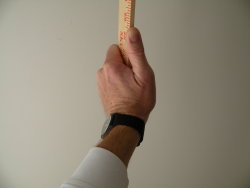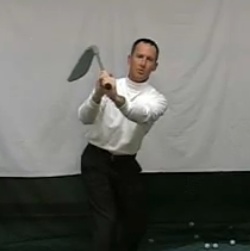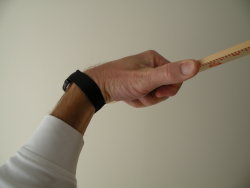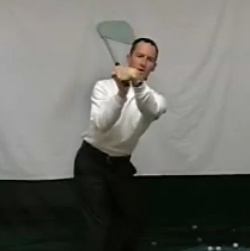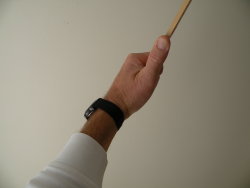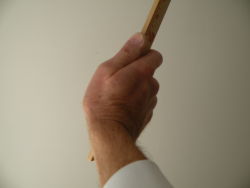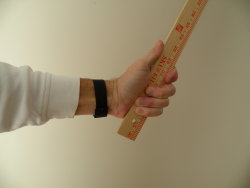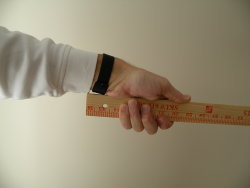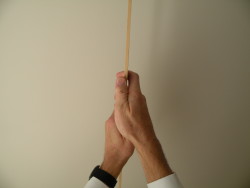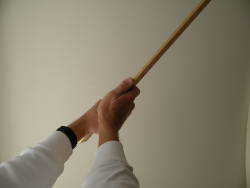The weight shift in the golf swing is a largely misunderstood concept. After all, how is one supposed to keep their head still, shift weight and stay behind the golf ball all during a swing that takes less than a second and a half to complete?
Fortunately, this online golf lesson article and the subsequent video golf lesson at the end will clear up all the mystery behind the proper weight shift in the golf swing.
It all starts with setup. Obviously the golfer is bowed forward with the chest somewhat over the ball, buttocks stuck out behind the heels counterbalancing the forward leaning chest. Weight is distributed evenly left and right and sits through the middle of the arches on the feet. In addition, the upper torso is leaning away from the target because the trailing hand and arm sit lower down the handle of the golf club. So to put it simply, bow forward and lean right if you are a right-handed golfer. Also notice your head will be behind the ball.
Golf Swing Weight Shift in Backswing
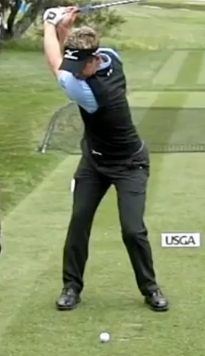
Now it gets tricky. If you try to “shift” weight to the right in the backswing, you will likely slide your hips over to the right while trying to keep your head still. Your core will have moved out from under your head, and your upper body will be tilted the wrong way – back toward the target. The spine angle has literally reversed itself.
You see, the term “shift” is all wrong for the backswing. “Pivot” is a better term. The right hip will pivot back like sitting back in a chair and then around – actually coiling back toward the target slightly, not drifting sideways to the right. The right foot will stay braced on the instep, and the leg will remain leaning inward like a ball player braced to push off for a throw.
This pivot motion with the hips also involves coiling the trunk around the spine – this is not the same as turning around a still head. If you coil correctly around your spine, which was bowed forward and to the right at address, your chest and head will naturally flow to the right.
Remember your spine is located along the rear of your trunk so your chest, head and eyes are located out in front of the spine. Spine stays still and turns while sending head, chest and eyes to the right. This moves the weight of your chest and head over your right foot and creates the correct golf swing weight shift sensation in the backswing.
This lateral movement of the head is minimal, probably 1”- 3” for most golfers, nevertheless there is movement. Bottom line, do not attempt to keep your head perfectly still while sliding your weight to the right. You will get a reverse spine tilt in the backswing that sends your downswing over the top and casting, or you will overcorrect the spine tilt back to the right in the downswing so hard you throw the club in the ground.
Golf Swing Weight Shift in Downswing
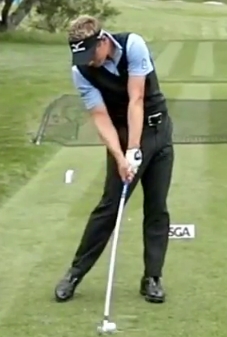
With the backswing pivot clarified, what do we do with weight shift on the downswing? It’s pretty simple actually. From the correct backswing position with the upper torso leaning away from target, all the player has to do is shift (yes, now it’s time to shift) the left knee and hip targetward as the downswing begins … actually both knees shift targetward.
This first move in the downswing is lateral, not circular or rotary, often cited as “clearing the hips.” Imagine leaving your back facing the target as your hips shift toward target. The hip clearing will gradually kick in a moment later as the arms lower to the waist-high area and the majority of weight has arrived on the front foot. At impact the golfer’s belt buckle will have shifted well left of the golf ball and will have begun turning left. The hands will also preferably be past the ball on all shots but the driver.
There you have it. Coil or pivot in the backswing, keeping the hips in a barrel as the old golf instruction cliché states. Be willing to allow the upper body to tilt to the right as the head likely drifts slightly to the right in backswing. Then blow out the left side of that barrel as the hips shift first, then clear on the downswing. The armswing will benefit by easily getting back well inside the ball in the backswing, then dropping in the slot on the downswing. No more over the top downswings or falling back off balance in the finish.
So what do you think? Are you willing to pivot the hips and let your head drift back in the backswing to develop a better weight shift and more repeatable downswing path with more power?
Watch the video golf lesson below, then try it out and leave your comments at the bottom of the page. Don’t forget to share this with your friends.
Herman

